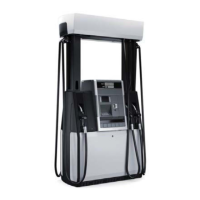2.4.1 No Flow - Flow Control Valve Off
Flow control valve “Off” or no flow occurs when the inlet to the valve is charged. But there is no
flow required from the particular valve as in the instance where a submersible pump motor is
running because another fueling point is being used. The pilot stays closed allowing pump
pressure to build on the back side of the piston, closing the outlet port.
2.4.2 Slow Flow - Flow Control Valve On
Flow control valve “On” slow flow occurs at the beginning of all sales, and again at the end of
preset sales. In this case the coil is energized with current bursts of shorter duration. This allows
the pilot to slightly move off its seat, allowing slow flow through the pilot orifice leading to the
valve outlet, but not relieving enough pressure to cause the piston to open.
2.4.3 Full Regulated Flow - Flow Control Valve On
Flow control valve “On” full regulated flow occurs during the main portion of all sales. At this
time, the coil is energized with bursts of current of longer duration, pulling the pilot further off it’s
seat, relieving the pressure balance, and allowing the piston to open by an amount relative to
the distance between pilot and the pilot orifice. The position of the pilot is constantly moving in
very small increments based on the signals sent from the computer relative to controlling a
specific blend ratio and/or maintaining a maximum flow rate of 38 lpm (10 gpm) through a hose.
As the computer senses the need to increase or decrease the amount of a particular feedstock,
it will send signals to the coil of longer (to open) or shorter (to close) duration. As a result, the
pilot moves up or down causing the piston to follow its movement and achieve the proper amount
of flow.
When the delivery is complete, the coil is de-energized, allowing the pilot to return to its closed
position. This allows pressure to build on the back side of the piston, forcing it to close and seal
the outlet port thereby stopping flow.
Coil
used in NA
Valve
Tube Retaining Pin
Conduit
Figure 2.3: Proportional Valve and Coil
16 WM048523 Rev 08 01/2019
2 Hydraulics

